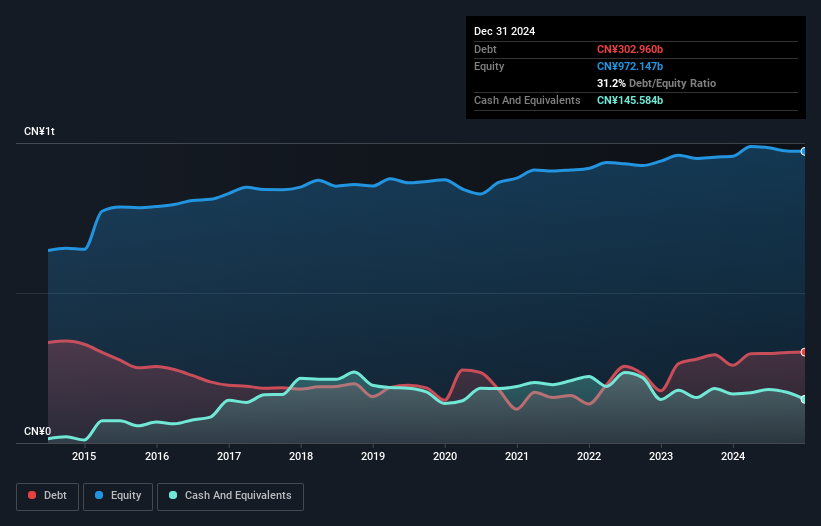
Warren Buffett famously said, 'Volatility is far from synonymous with risk.' So it seems the smart money knows that debt - which is usually involved in bankruptcies - is a very important factor, when you assess how risky a company is. Importantly, China Petroleum & Chemical Corporation (HKG:386) does carry debt. But should shareholders be worried about its use of debt?
Our free stock report includes 1 warning sign investors should be aware of before investing in China Petroleum & Chemical. Read for free now.When Is Debt Dangerous?
Debt is a tool to help businesses grow, but if a business is incapable of paying off its lenders, then it exists at their mercy. In the worst case scenario, a company can go bankrupt if it cannot pay its creditors. However, a more common (but still painful) scenario is that it has to raise new equity capital at a low price, thus permanently diluting shareholders. Having said that, the most common situation is where a company manages its debt reasonably well - and to its own advantage. When we think about a company's use of debt, we first look at cash and debt together.
How Much Debt Does China Petroleum & Chemical Carry?
You can click the graphic below for the historical numbers, but it shows that as of December 2024 China Petroleum & Chemical had CN¥303.0b of debt, an increase on CN¥258.8b, over one year. However, because it has a cash reserve of CN¥145.6b, its net debt is less, at about CN¥157.4b.

How Strong Is China Petroleum & Chemical's Balance Sheet?
The latest balance sheet data shows that China Petroleum & Chemical had liabilities of CN¥673.2b due within a year, and liabilities of CN¥436.1b falling due after that. Offsetting these obligations, it had cash of CN¥145.6b as well as receivables valued at CN¥80.8b due within 12 months. So its liabilities outweigh the sum of its cash and (near-term) receivables by CN¥882.9b.
Given this deficit is actually higher than the company's massive market capitalization of CN¥644.9b, we think shareholders really should watch China Petroleum & Chemical's debt levels, like a parent watching their child ride a bike for the first time. In the scenario where the company had to clean up its balance sheet quickly, it seems likely shareholders would suffer extensive dilution.
See our latest analysis for China Petroleum & Chemical
We use two main ratios to inform us about debt levels relative to earnings. The first is net debt divided by earnings before interest, tax, depreciation, and amortization (EBITDA), while the second is how many times its earnings before interest and tax (EBIT) covers its interest expense (or its interest cover, for short). Thus we consider debt relative to earnings both with and without depreciation and amortization expenses.
While China Petroleum & Chemical's low debt to EBITDA ratio of 0.93 suggests only modest use of debt, the fact that EBIT only covered the interest expense by 5.7 times last year does give us pause. But the interest payments are certainly sufficient to have us thinking about how affordable its debt is. The bad news is that China Petroleum & Chemical saw its EBIT decline by 17% over the last year. If earnings continue to decline at that rate then handling the debt will be more difficult than taking three children under 5 to a fancy pants restaurant. There's no doubt that we learn most about debt from the balance sheet. But ultimately the future profitability of the business will decide if China Petroleum & Chemical can strengthen its balance sheet over time. So if you want to see what the professionals think, you might find this free report on analyst profit forecasts to be interesting.
Finally, a company can only pay off debt with cold hard cash, not accounting profits. So we clearly need to look at whether that EBIT is leading to corresponding free cash flow. Over the last three years, China Petroleum & Chemical saw substantial negative free cash flow, in total. While investors are no doubt expecting a reversal of that situation in due course, it clearly does mean its use of debt is more risky.
Our View
To be frank both China Petroleum & Chemical's EBIT growth rate and its track record of converting EBIT to free cash flow make us rather uncomfortable with its debt levels. But on the bright side, its net debt to EBITDA is a good sign, and makes us more optimistic. Taking into account all the aforementioned factors, it looks like China Petroleum & Chemical has too much debt. That sort of riskiness is ok for some, but it certainly doesn't float our boat. The balance sheet is clearly the area to focus on when you are analysing debt. However, not all investment risk resides within the balance sheet - far from it. For instance, we've identified 1 warning sign for China Petroleum & Chemical that you should be aware of.
At the end of the day, it's often better to focus on companies that are free from net debt. You can access our special list of such companies (all with a track record of profit growth). It's free.
Have feedback on this article? Concerned about the content? Get in touch with us directly. Alternatively, email editorial-team (at) simplywallst.com.
This article by Simply Wall St is general in nature. We provide commentary based on historical data and analyst forecasts only using an unbiased methodology and our articles are not intended to be financial advice. It does not constitute a recommendation to buy or sell any stock, and does not take account of your objectives, or your financial situation. We aim to bring you long-term focused analysis driven by fundamental data. Note that our analysis may not factor in the latest price-sensitive company announcements or qualitative material. Simply Wall St has no position in any stocks mentioned.